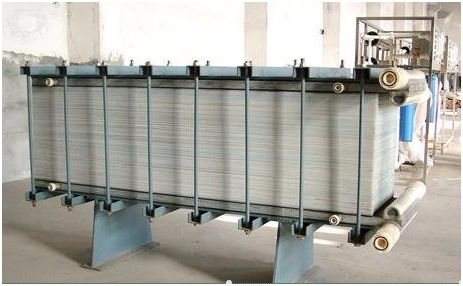Electrodialysis
Ⅰ、Principle
The semi-permeable membrane used in electrodialysis is actually an ion exchange membrane. This kind of ion exchange membrane can be divided into cation exchange membrane (positive membrane) and anion exchange membrane (negative membrane) according to the charge properties of ions. In electrolyte solution, the anion membrane allows the cation to pass through and repel to block the anion, while the anion membrane allows the anion to pass through and repel to block the cation, which is the selective transmittance of the ion exchange membrane. In the electrodialysis process, the ion exchange membrane does not exchange with some ions in aqueous solution as the ion exchange resin does, but only plays a selective transmission role for ions with different electrical properties, that is, the ion exchange membrane does not need to be regenerated. The electrodialysis process consists of electrodes and membranes in a compartment called a polar compartment, in which the electrochemical reaction occurs in the same way as the conventional electrode reaction. Oxidation reaction occurs in the anode chamber. The anodic water is acidic and the anode itself is easy to be corroded. Reduction reaction took place in the cathode room, the cathode water was alkaline, and the cathode was easy to scale.
Ⅱ、Range of application
At present, electrodialysis machine is widely used in water desalination and desalination, seawater concentration and salt refining dairy products, fruit juice deacidification and purification, chemical products and other aspects, but also used in food, light industry and other industries to produce pure water, electronics, medicine and other industries to produce high pure water pretreatment. The primary softening desalting of boiler feed water desalts brackish water to drinking water.
Electrodialyzer is suitable for water treatment of electronics, medicine, chemical industry, thermal power generation, food, beer, beverage, printing and dyeing and coating industries. It can also be used for material concentration, purification, separation and other physical and chemical processes.
Electrodialysis can also be used in the treatment of waste water and liquid and the recovery of precious metals, such as nickel from electroplating waste liquid.
Ⅲ、Basic performance
(1) Operating pressure 0.5─3.0kg /cm2 or so
(2)Operating voltage and current 100-250V, 1-3A
(3)Body power consumption is about 0.2-2.0 degrees per ton of fresh water
Ⅳ、Methods the characteristics of
①It can desalinate, concentrate, separate and purify the electrolyte solution at the same time. electrodialysis
②It can be used for purification of non-electrolytes such as sucrose to remove the electrolytes;
③In principle, the electrodialyzer is an electrolytic cell with a diaphragm that makes use of the REDOX efficiency on the electrode.
Ⅴ、The following secondary processes are also carried out during electrodialysis
①With the migration of the same name ions, the selective permeability of the ion exchange membrane is often not 100%, so there will always be a small number of opposite ions through the exchange membrane.
②Concentration diffusion of ions. Due to the concentration difference between the solution in the concentration chamber and the desalination chamber, a small amount of ions always migrate from the concentration chamber to the desalination chamber, thus reducing the dialysis efficiency.
③Although the exchange membrane does not allow solvent molecules to penetrate, some solvent molecules (water) will permeate the concentration chamber due to the difference in concentration between the desalination chamber and the concentration chamber.
④In the electrodialysis of water, due to the hydration of ions and the formation of a double layer, water molecules can also migrate from the desalination chamber to the concentration chamber under the action of a direct current electric field.
⑤The polarized ionization of water, sometimes due to poor working conditions, forces the water and electricity to be separated into hydrogen ions and hydroxide ions, which can enter the concentration chamber through the exchange membrane.
⑥Pressure infiltration of water, due to the difference in fluid pressure between the concentration chamber and the desalination chamber, forces the water molecules to penetrate from the side with high pressure to the side with low pressure. Obviously, these secondary processes are detrimental to electrodialysis, but they can all be avoided or controlled by changing operating conditions.


